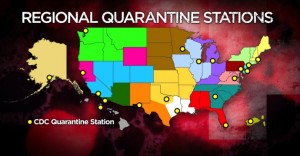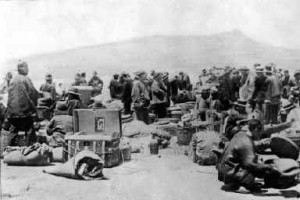
US Public Health Service officers then, as now, wear uniforms. This photo from 1912 shows the officers performing quarantine duty. From CDC archives
Nurse Kaci Hickox went for a bicycle ride this morning , defying Maine’s order to quarantine her. Hickox says that Maine’s quarantine is not based on “evidence-based medicine.” Hickox is correct that evidence based medicine states since she is asymptomatic, and was laboratory tested negative for Ebola, she should be allowed her freedom. Hickox and her lawyers believe that placing her in quarantine is removing her civil rights. Maine state law allows broad authority to quarantine individuals who represent “a clear and imminent public health threat.”
The question for the courts is if Hickox is an “imminent threat” and if that should be determined by medical evidence, or if this is a question to be left to an opinion outside of medical evidence. The slippery slope of allowing politicians with their co-opted physicians to remove a person’s civil rights.
The guidelines from the experts, such as the Centers for Disease Control, state she should self-monitor twice daily for a fever. If she develops a fever she would then proceed to an isolation unit for further testing. Hickox states she will comply with CDC guidelines.
Hickox was confined to isolation when she arrived in New Jersey, and threatened to sue in order to obtain her freedom to return home. Maine initially welcomed her home, the governor calling her a hero for volunteering to help with Doctors Without Borders working with Ebola patients.
Any politician can obtain a physician to state a medical opinion – but in this case it is the determination of the weight of science and evidence based medicine against an opinion of a doctor aligned with a politician.
Removing civil rights from ill individuals with psychiatric illness have a defined, and court process. It may be that the establishment of a similar system will be needed for infectious disease. Infectious disease has had a long history of isolations and quarantines, but now the process is being challenged.
Quarantine comes from the Italian quaranta giorni, translates to 40 days- the first known quarantines of ships arriving to Venice that came from ports where the Plaque was endemic. Those ships would have to remain anchored for forty days.
In the early years of the United States there was no federal regulations for the quarantine of individuals, it was left up to the states. That had to change in 1878 with outbreaks of yellow fever that crossed state lines. Congress still left it to the states to maintain the authority for quarantines. Over time states turned the authority for quarantine to the federal government.
The Public Health Services Act of 1944 established the responsibility for quarantines to the federal government and ultimately the authority was transferred to the Center for Disease Control, where it resides today. The Public Health Services and now “The Division of Global Migration and Quarantine” has quarantine stations in Anchorage, Atlanta, Boston, Chicago, Dallas, Detroit, El Paso, Honolulu, Houston, Los Angeles, Miami, Minneapolis, New York, Newark, Philadelphia, San Diego, San Francisco, San Juan, Seattle, and Washington D.C.

Quarantine stations – from dabrownstein.wordpress.com
Currently Ebola is on the list of diseases that allow for quarantine practices; also on the list are cholera, diphtheria, tuberculosis, plague, smallpox, yellow fever, severe acute respiratory syndromes (SARS), and the other hemorrhagic fevers besides Ebola – Marburg and Congo-Crimean.
FEDERAL LAW:
The isolation and quarantine comes from the Commerce Clause of the U.S. Constitution and was further revised by the Public Health Services Act.
NON FEDERAL LAWS:
The state and local authorities (as well as tribal authorities for Native American reservations or federally recognized villages) can enforce isolation within their borders. This has been the case since the founding of the United States
DEFINITIONS:
Isolation – separates sick people with a contagious disease from people who are not sick. If someone is sick with certain diseases they are isolated from non-sick people. Many people confuse isolation with quarantine.
Quarantine – separates and restricts the movement of people who were exposed to a contagious disease to see if they become sick. These people are not sick – but have been exposed to, or may have been exposed to people who are ill.
ANGEL ISLAND:

Immigrants in quarantine are preparing their baggage for disinfection. Tiburon peninsula is seen in the background.

Disinfecting tubes from Angel Island. Live steam and chemicals were used to disinfect potential pathogens
Perhaps one of the best preserved quarantine stations was at Hospital Cove, near Berkeley, California. In 1891 a Quarantine Station was opened where ships from foreign ports would doc and immigrants would be inspected by the local physicians. The ships could also be fumigated.
The steamship China was isolated there on April 1891 because smallpox was on board. Passengers were checked by the doctor, bathed with carbolic soap, and given new clothes to wear. Clothing and baggage were disinfected with live steam and passengers were placed in barracks for two weeks. The barracks were fumigated with sulfur and flushed with salt water ever morning (later other chemicals were used).
The station was decommissioned in 1948 and is now a state park where some of the facilities remain.
